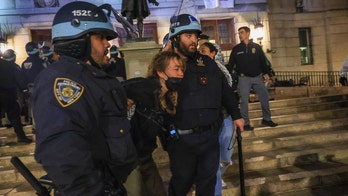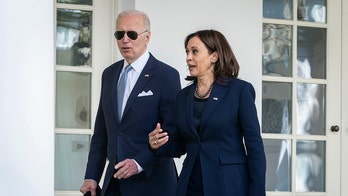
April 15: A Capitol Police officer flashes a thumbs up after inspecting the small helicopter a man landed on the West Lawn of the Capitol. (AP)
WASHINGTON – The mail must go through…
Apparently, right through a canopy of protected airspace which seals the White House and the U.S. Capitol from potential terrorist threats aloft.
The mail must be ferried right to the west lawn of the U.S. Capitol, about 150 yards from the speaker’s office, transported via a single-propeller gyrocopter. It’s a flying contraption which looks like it was assembled by Dr. Seuss.
Doug Hughes, a 61-year-old mailman from Ruskin, Fla., penned letters to all 535 Members of Congress. He wanted to make a point about exorbitant money in politics.
Hughes did make a point – just not the one he intended.
Nearly 14 years after terrorists intended to crash a jetliner into the Capitol on 9/11, Hughes demonstrated how America’s seat of government remains vulnerable to a possible attack from above.
Gyrocopters max out at around 45 miles- per-hour and reach an altitude of 300 ft. So it’s no surprise that one eyewitness to Wednesday’s Capitol airshow compared the image of Hughes’s gyrocopter arcing across the sky to ET. Air defense systems protect the Capitol and other federal buildings in downtown Washington. But considering the 9/11 model, the government arrayed those installations to take out traditional aircraft approaching from higher elevations.
In other words, Hughes could fly almost literally below the radar.
This was a mailman from Florida. What happens when the Islamic State militants take flight?
A gyrocopter is not a drone. But the concern is similar. Just a few months ago, federal officials fretted after someone landed a drone on the White House grounds. Del. Eleanor Holmes Norton, D-D.C., argued that the Secret Service needed clarity from the Federal Aviation Administration on the operation of drones in federal no-fly zones. Last August, U.S. Capitol Police detained a man who flew a drone on the Capitol grounds. By the way, the USCP banned piloting drones around the Capitol. It’s right there in Section 16.2.90 of USCP regulations prohibiting “the use of model rockets, remote or manually controlled model gliders, model airplanes or unmanned aircrafts.”
USCP rule 16.2.80 also informs people they can’t go fly a kite at the Capitol.
Although that might be what Hughes was trying to tell lawmakers when it comes to how they finance political campaigns.
This is what bewilders lawmakers: How could an unauthorized aircraft of any sort creep this close to the U.S. Capitol? And what could anyone do about it?
House Homeland Security Committee Chairman Michael McCaul, R-Texas, told The Associated Press moments after the incident that police could have shot down the gyrocopter had it flown much closer to the Capitol. No one’s exactly sure how that would have happened since Hughes landed about 150 yards short of the balcony leading to the office of House Speaker John Boehner, R-Ohio.
Other lawmakers speculated officers could have shot at Hughes with long guns. Hughes plopped down his craft toward the bottom of a grassy slope immediately in front of the Capitol. The location is where workers construct a bandstand and stage for the annual Memorial Day and 4th of July concerts. The spot is just steps from where a man shot and killed himself on Capitol Hill over the weekend. It’s not clear how law enforcement could have brought down Hughes between where he landed and the Capitol itself - especially if his intent were malevolent and he intended to crash the gyrocopter into the building.
Of course, Wednesday afternoon’s episode wasn’t without precedent.
There have been other air incursions over the years at the Capitol. Interestingly, they usually unfold on sparkling, spring days of unrivaled beauty and clear skies. That’s when amateur pilots, restless from cabin fever, unwrap their Cessnas and Pipers from nylon coverings and take to the skies. Some wander off course into Washington. The Air Force or Air National Guard scrambles jets. They intercept the offending aircraft and escort them to a nearby airfield in Leesburg, Va. or Frederick, Md.
In the first few years after September 11th, these airplane forays prompted utter pandemonium at the Capitol. The USCP sent lawmakers, staff and tourists dashing in fear as officials tried to clear the campus. The worst instance happened in June, 2004, just as a memorial service was about to begin in the Capitol Rotunda for President Reagan. All possible security measures were operational at the Capitol as world leaders like Mikhail Gorbachev and Margaret Thatcher lined up to pay their final respects.
And then a Kentucky State Police plane carrying then-Kentucky Gov. Ernie Fletcher veered off line. Authorities scrambled F-16s and the Capitol descended into bedlam. It was an unmitigated jailbreak with people sprinting from the Capitol for their very lives. Some people were injured in the process.
In the years since, officials drastically improved how they handle possible air incursions. But in Hughes’s case, there was no warning. In fact, multiple lawmakers and Congressional aides complained that authorities provided nary a single warning, update or instructions on the gyrocopter. A couple of lawmakers groused that they only learned about the situation from media.
The USCP quickly cordoned off a several block radius on the Capitol’s West Front. Constitution and Independence Avenues on both sides of the Capitol remained open. Meantime, Congressional business continued inside. Iraqi Prime Minister Haider al-Adabi met as scheduled with Senate Majority Leader Mitch McConnell, R-Ky., and Minority Leader Harry Reid, D-Nev.
A ceremony unfolded in the Capitol Visitor’s Center, bestowing the Congressional Gold Medal on the Doolittle Tokyo Raiders. It was the U.S.’s first attack on the Japanese mainland after Pearl Harbor – and a daring one at that. The House and Senate remained in session. Senate Budget Committee Chairman Mike Enzi, R-Wyo., led a debate about budget provisions. House Ways and Means Committee Chairman Paul Ryan, R-Wis., managed a tax policy bill on the floor.
Most operations inside the Capitol appeared to be business as usual.
But the dichotomous security posture seemed unsettling – considering the potential for disaster had Hughes’s intent been sinister.
Some on Capitol Hill raised serious ethics questions about the Tampa Bay Times. The Times was apparently in on Hughes’s stunt months in advance and even dispatched staffers to Washington to document the exploits. Should the newspaper been involved in the antic, regardless of potential for panic and the security hazard it posed to the Capitol?
“What if it would have crashed into the building?” asked one source who asked not to be identified. “What if (Hughes) would have been killed?”
The Tampa Bay Times argued that law enforcement officials were aware of Hughes’s plan and that he posed no threat. There was also word that someone tipped off the Secret Service about Hughes’s gambit.
“Media reports indicating that the Secret Service Tampa Field Office was alerted earlier today by a citizen to the subject’s intentions are false,” said Secret Service spokesman Brian Leary.
Meantime, the scene outside the Capitol devolved into a nervous curiosity about the gyrocopter. The USCP dispatched a small robot, reminiscent of NASA’s Mars rover, to inspect the vehicle for explosives or bombs. Crowds of tourists teamed near the United States Botanic Garden to watch the show. Some tourists plopped down on the steps of the reflecting pool, adjusted their sunglasses and sipped soda. Meantime a paddling of ducks navigated the reflecting pool, oblivious to the odd scene unfolding behind them.
The mail must go through.




